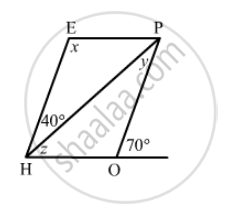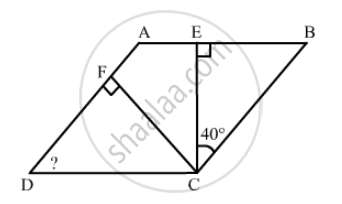Advertisements
Advertisements
Question
Diagonals of a rhombus are 20 cm and 21 cm respectively, then find the side of rhombus and its perimeter.
Solution

Let `square`ABCD be the rhombus.
AC = 20 cm, BD = 21 cm
AO = `1/2` AC ...[Diagonals of a rhombus bisect each other]
= `1/2 xx 20`
= 10 cm ...(i)
BO = `1/2` BD ...[Diagonals of a rhombus bisect each other]
= `1/2 xx21`
= `21/2`
= 10.5 cm ...(ii)
In ∆AOB,
∠AOB = 90° ...[Diagonals of a rhombus are perpendicular to each other]
By Pythagoras theorem,
∴ AB2 = AO2 + BO2
∴ AB2 = 102 + 10.52
∴ AB2 = 100 + 110.25
∴ AB2 = 210.25
∴ AB = `sqrt(210.25)`
∴ AB = 14.5 cm
Perimeter of `square`ABCD = 4 × AB
= 4 × 14.5
= 58 cm
APPEARS IN
RELATED QUESTIONS
In the adjacent figure HOPE is a parallelogram. Find the angle measures x,y and z. State the geometrical truths you use to find them.

Two opposite angles of a parallelogram are (3x − 2)° and (50 − x)°. Find the measure of each angle of the parallelogram.
All the angles of a quadrilateral are equal to each other. Find the measure of each. Is the quadrilateral a parallelogram? What special type of parallelogram is it?
Find the angles marked with a question mark shown in Fig. 17.27

Which of the following statement is true for a rhombus?
It has two pairs of equal sides.
Which of the following statement is true for a rhombus?
Two of its angles are at right angles
Which of the following statement is true for a rhombus?
Its diagonals are equal and perpendicular.
Which of the following statement is true for a rhombus?
It has all its sides of equal lengths.
Identify all the quadrilateral that have Four sides of equal length
The given figure shows a rhombus ABCD in which angle BCD = 80°. Find angles x and y.

